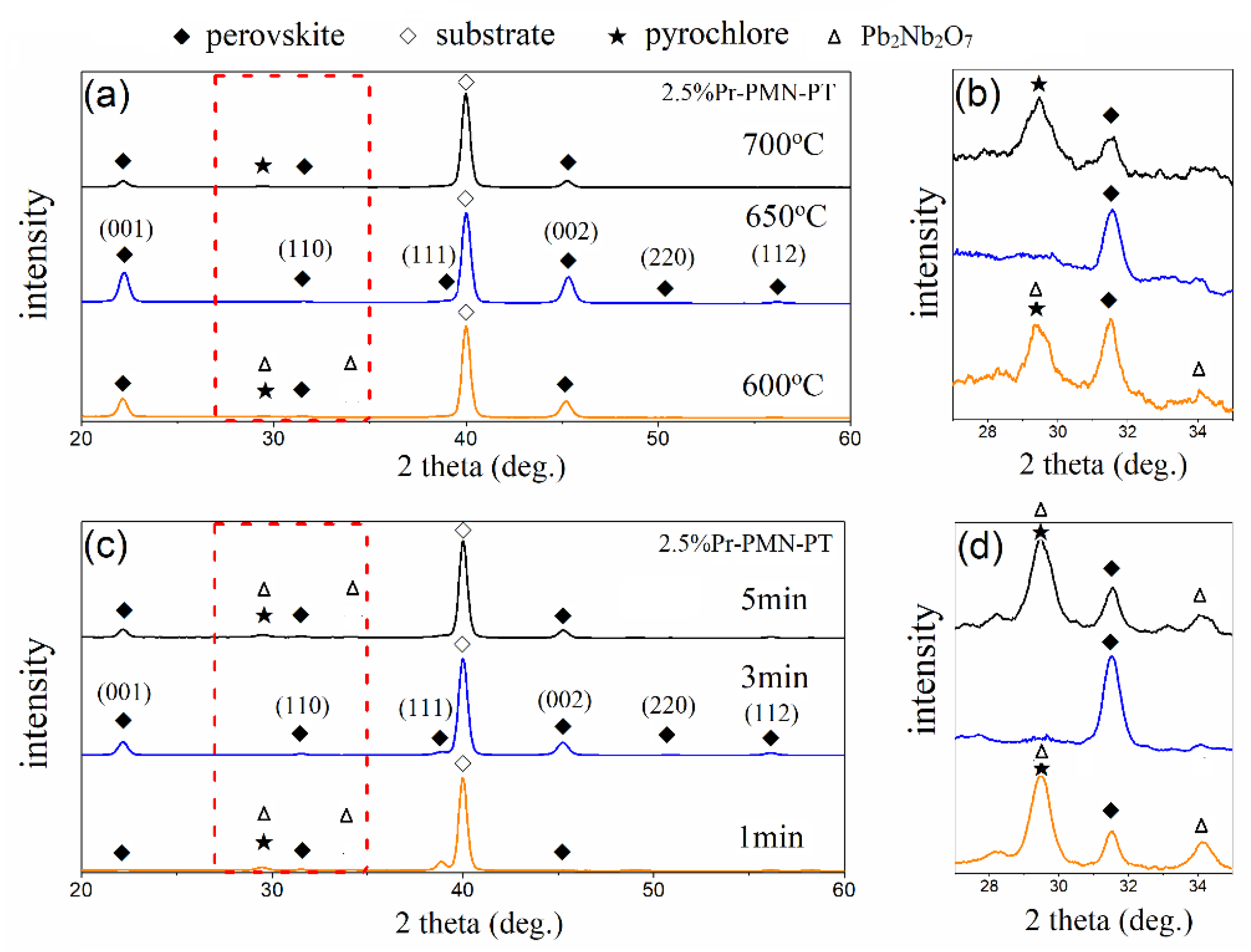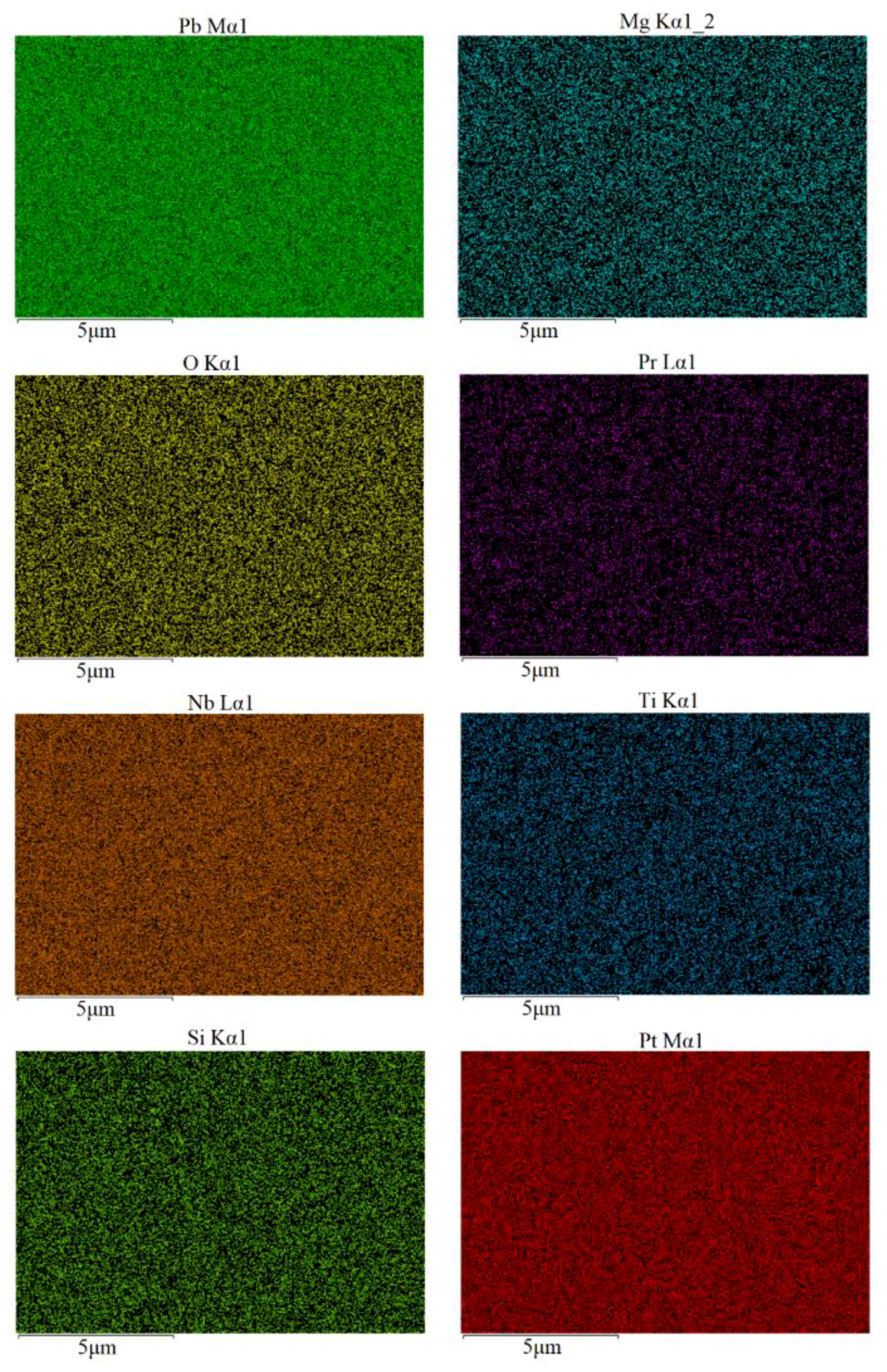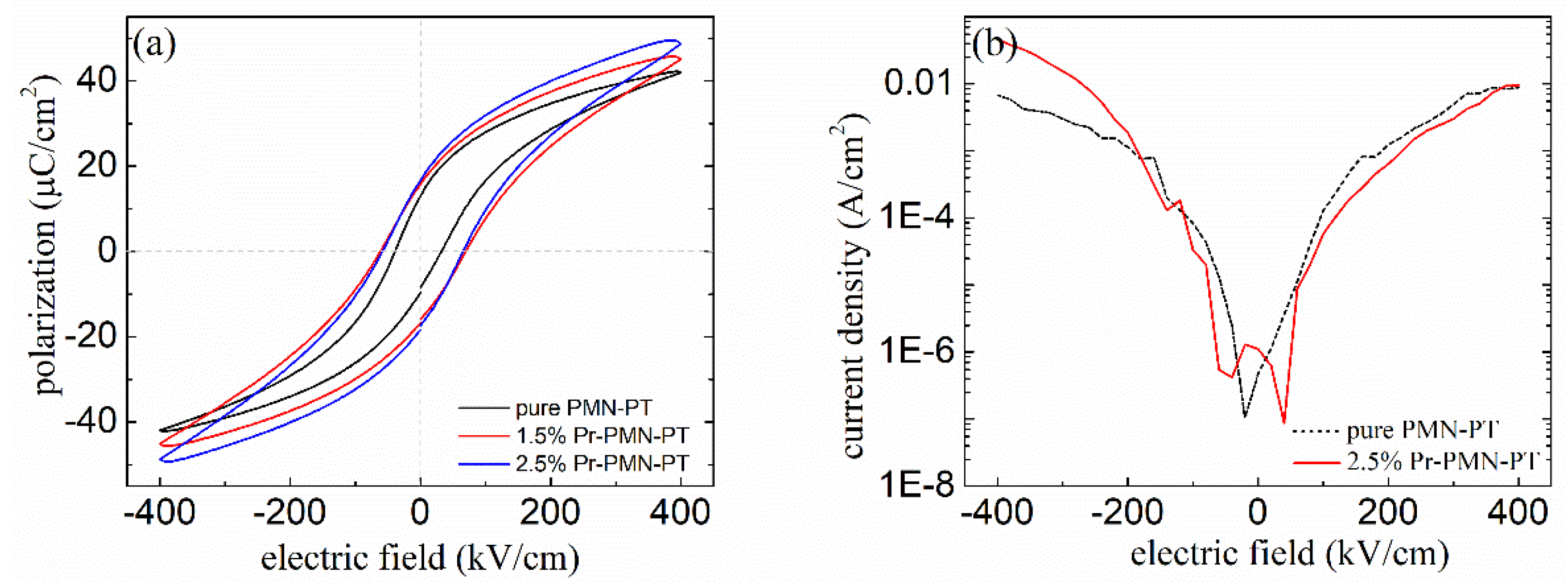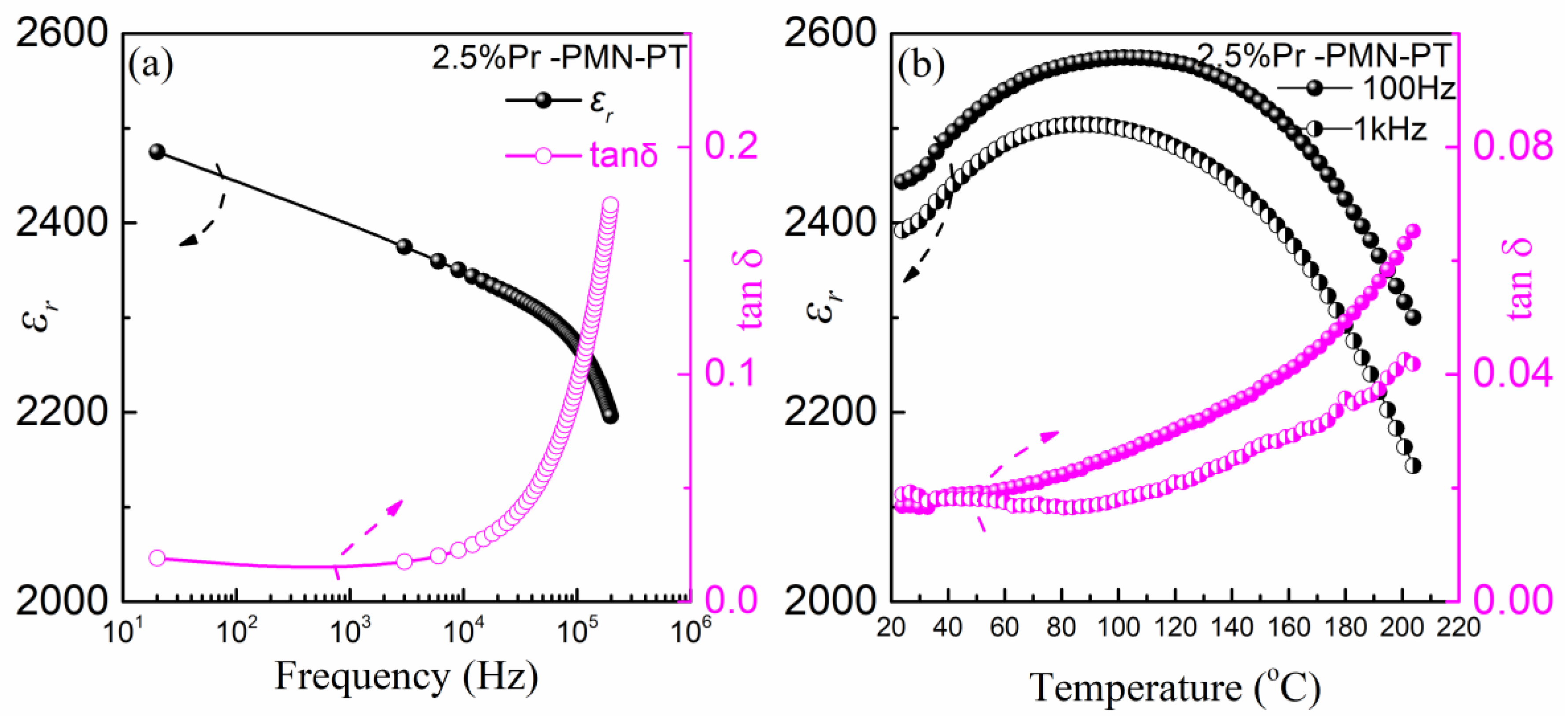Synthesis, Giant Dielectric, and Pyroelectric Response of [001]-Oriented Pr3+ Doped Pb(Mg1/3Nb2/3)O3-PbTiO3 Ferroelectric Nano-Films Grown on Si Substrates
Abstract
1. Introduction
2. Materials and Methods
3. Results and Discussion
3.1. Phase Structure
3.2. Surface Morphology and Electric Properties at Room Temperature
3.3. Ferroelectric Properties
3.4. Temperature Dependent of Dielectric and Pyroelectric Properties
4. Conclusions
Author Contributions
Funding
Acknowledgments
Conflicts of Interest
References
- Baek, S.-H.; Rzchowski, M.S.; Aksyuk, V.A. Giant piezoelectricity in PMN-PT thin films: Beyond PZT. MRS Bull. 2012, 37, 1022–1029. [Google Scholar] [CrossRef]
- Cordero, F. Elastic Properties and Enhanced Piezoelectric Response at Morphotropic Phase Boundaries. Materials 2015, 8, 5452. [Google Scholar] [CrossRef] [PubMed]
- Lin, D.; Li, Z.; Cheng, Z.Y.; Xu, Z.; Yao, X. Electric-field-induced polarization fatigue of [001]-oriented Pb(Mg1/3Nb2/3)O3–0.32PbTiO3 single crystals. Solid State Commun. 2011, 151, 1188–1191. [Google Scholar] [CrossRef]
- Pandya, S.; Wilbur, J.; Kim, J.; Gao, R.; Dasgupta, A.; Dames, C.; Martin, L.W. Pyroelectric energy conversion with large energy and power density in relaxor ferroelectric thin films. Nat. Mater. 2018, 17, 432. [Google Scholar] [CrossRef] [PubMed]
- Lee, S.H.; Jeong, C.K.; Hwang, G.-T.; Lee, K.J. Self-powered flexible inorganic electronic system. Nano Energy 2015, 14, 111–125. [Google Scholar] [CrossRef]
- Zhang, S.; Li, F.; Lee, H.J.; Lin, D.; Shrout, T.R.; Luo, J.; Meyer, R.J. Evaluation of PMN-PT based crystals for various applications. In Proceedings of the 2011 International Symposium on Applications of Ferroelectrics (ISAF/PFM) and 2011 International Symposium on Piezoresponse Force Microscopy and Nanoscale Phenomena in Polar Materials, Vancouver, BC, Canada, 24–27 July 2011; pp. 1–4. [Google Scholar]
- Moya, X.; Defay, E.; Mathur, N.D.; Hirose, S. Electrocaloric effects in multilayer capacitors for cooling applications. MRS Bull. 2018, 43, 291–294. [Google Scholar] [CrossRef]
- Zhang, T.; Ou-Yang, J.; Yang, X.; Zhu, B. Transferred PMN-PT Thick Film on Conductive Silver Epoxy. Materials 2018, 11, 1621. [Google Scholar] [CrossRef] [PubMed]
- Chen, Y.; Lam, K.-H.; Zhou, D.; Yue, Q.; Yu, Y.; Wu, J.; Qiu, W.; Sun, L.; Zhang, C.; Luo, H.; et al. High Performance Relaxor-Based Ferroelectric Single Crystals for Ultrasonic Transducer Applications. Sensors 2014, 14, 13730. [Google Scholar] [CrossRef] [PubMed]
- Lin, D.; Lee, H.J.; Zhang, S.; Li, F.; Li, Z.; Xu, Z.; Shrout, T.R. Influence of domain size on the scaling effects in Pb(Mg1/3Nb2/3)O3–PbTiO3 ferroelectric crystals. Scripta Mater. 2011, 64, 1149–1151. [Google Scholar] [CrossRef] [PubMed]
- Park, S.-E.; Shrout, T.R. Ultrahigh strain and piezoelectric behavior in relaxor based ferroelectric single crystals. J. Appl. Phys. 1997, 82, 1804–1811. [Google Scholar] [CrossRef]
- Choi, S.W.; Shrout, R.T.R.; Jang, S.J.; Bhalla, A.S. Dielectric and pyroelectric properties in the Pb(Mg1/3Nb2/3)O3-PbTiO3 system. Ferroelectrics 1989, 100, 29–38. [Google Scholar] [CrossRef]
- Li, F.; Zhang, S.; Xu, Z.; Chen, L.-Q. The Contributions of Polar Nanoregions to the Dielectric and Piezoelectric Responses in Domain-Engineered Relaxor-PbTiO3 Crystals. Adv. Funct. Mater. 2017, 27, 1700310. [Google Scholar] [CrossRef]
- Kazys, R.; Sliteris, R.; Sestoke, J. Air-Coupled Ultrasonic Receivers with High Electromechanical Coupling PMN-32%PT Strip-Like Piezoelectric Elements. Sensors 2017, 17, 2365. [Google Scholar] [CrossRef] [PubMed]
- Swartz, S.L.; Shrout, T.R. Fabrication of perovskite lead magnesium niobate. Mater. Res. Bull. 1982, 17, 1245–1250. [Google Scholar] [CrossRef]
- Lin, D.; Li, Z.; Li, F.; Xu, Z.; Yao, X. Characterization and piezoelectric thermal stability of PIN–PMN–PT ternary ceramics near the morphotropic phase boundary. J. Alloys Compd. 2010, 489, 115–118. [Google Scholar] [CrossRef]
- Lin, D.; Li, Z.; Zhang, S.; Xu, Z.; Yao, X. Electric-field and temperature induced phase transitions in Pb(Mg1/3Nb2/3)O3–0.3PbTiO3 single crystals. J. Appl. Phys. 2010, 108, 034112. [Google Scholar] [CrossRef]
- Shen, B.; Wang, J.; Pan, H.; Chen, J.; Wu, J.; Chen, M.; Zhao, R.; Zhu, K.; Qiu, J. Effects of annealing process and the additive on the electrical properties of chemical solution deposition derived 0.65Pb(Mg1/3Nb2/3)O3–0.35PbTiO3 thin films. J. Mater. Sci. Mater. Electron. 2018, 29, 16997–17002. [Google Scholar] [CrossRef]
- Keech, R.; Morandi, C.; Wallace, M.; Esteves, G.; Denis, L.; Guerrier, J.; Johnson-Wilke, R.L.; Fancher, C.M.; Jones, J.L.; Trolier-McKinstry, S. Thickness-dependent domain wall reorientation in 70/30 lead magnesium niobate-lead titanate thin films. J. Am. Ceram. Soc. 2017, 100, 3961–3972. [Google Scholar] [CrossRef]
- Keech, R.; Shetty, S.; Wang, K.; Trolier-McKinstry, S. Management of Lead Content for Growth of {001}-Oriented Lead Magnesium Niobate-Lead Titanate Thin Films. J. Am. Ceram. Soc. 2016, 99, 1144–1146. [Google Scholar] [CrossRef]
- Borman, T.M.; Zhu, W.; Wang, K.; Ko, S.W.; Mardilovich, P.; Trolier-McKinstry, S.E. Effect of lead content on the performance of niobium-doped {100} textured lead zirconate titanate films. J. Am. Ceram. Soc. 2017, 100, 3558–3567. [Google Scholar] [CrossRef]
- Herdier, R.; Detalle, M.; Jenkins, D.; Soyer, C.; Remiens, D. Piezoelectric thin films for MEMS applications—A comparative study of PZT, 0.7PMN-0.3PT and 0.9PMN-0.1PT thin films grown on Si by r.f. magnetron sputtering. Sens. Actuators A Phys. 2008, 148, 122–128. [Google Scholar] [CrossRef]
- Yutaka, T.; Kosuke, S.; Hiroshi, T.; Kunisaburo, T. Preparation of Lead Magnesium Niobate Titanate Thin Films by Chemical Vapor Deposition. Jpn. J. Appl. Phys. 1995, 34, 5083. [Google Scholar]
- Keech, R.; Shetty, S.; Kuroda, M.A.; Liu, X.H.; Martyna, G.J.; Newns, D.M.; Trolier-McKinstry, S. Lateral scaling of Pb(Mg1/3Nb2/3)O3-PbTiO3 thin films for piezoelectric logic applications. J. Appl. Phys. 2014, 115, 234106. [Google Scholar] [CrossRef]
- Kim, Y.-H.; Heo, J.-S.; Kim, T.-H.; Park, S.; Yoon, M.-H.; Kim, J.; Oh, M.S.; Yi, G.-R.; Noh, Y.-Y.; Park, S.K. Flexible metal-oxide devices made by room-temperature photochemical activation of sol–gel films. Nature 2012, 489, 128. [Google Scholar] [CrossRef] [PubMed]
- Karataş, Ş.; El-Nasser, H.M.; Al-Ghamdi, A.A.; Yakuphanoglu, F. High Photoresponsivity Ru-doped ZnO/p-Si Heterojunction Diodes by the Sol-gel Method. Silicon 2018, 10, 651–658. [Google Scholar] [CrossRef]
- Zhou, D.; Sun, H.; Liu, X.; Sui, H.; Guo, Q.; Liu, P.; Ruan, Y. Effects of annealing temperature on structure and electrical properties of sol-gel derived 0.65PMN-0.35PT thin film. Ceram. Int. 2017, 43, 5901–5906. [Google Scholar] [CrossRef]
- Yao, Y.; Luo, L.; Li, W.; Zhou, J.; Wang, F. An intuitive method to probe phase structure by upconversion photoluminescence of Er3+ doped in ferroelectric Pb(Mg1/3Nb2/3)O3-PbTiO3. Appl. Phys. Lett. 2015, 106, 082906. [Google Scholar] [CrossRef]
- Yang, M.; Long, S.; Yang, X.; Lin, S.; Zhu, Y.; Ma, D.; Wang, B. Temperature-Dependent and Threshold Behavior of Sm3+ Ions on Fluorescence Properties of Lithium Niobate Single Crystals. Materials 2018, 11, 2058. [Google Scholar] [CrossRef] [PubMed]
- Li, F.; Lin, D.; Chen, Z.; Cheng, Z.; Wang, J.; Li, C.; Xu, Z.; Huang, Q.; Liao, X.; Chen, L.-Q.; et al. Ultrahigh piezoelectricity in ferroelectric ceramics by design. Nat. Mater. 2018, 17, 349. [Google Scholar] [CrossRef] [PubMed]
- Yang, L.; Zheng, D.-Y.; Guo, K.-X.; Zhao, W.-N.; Peng, Z.-H.; Peng, G.-G.; Zhou, T. Mechanism of grain growth and excellent polarization, dielectric relaxtion of La3+, Nd3+ modified PZT nano-films prepared by sol–gel technique. J. Mater. Sci. Mater. Electron. 2018, 29, 18011–18019. [Google Scholar] [CrossRef]
- Feng, M.; Wang, W.; Ke, H.; Rao, J.C.; Zhou, Y. Highly (111)-oriented and pyrochlore-free PMN–PT thin films derived from a modified sol–gel process. J. Alloys Compd. 2010, 495, 154–157. [Google Scholar] [CrossRef]
- Gabor, U.; Spreitzer, M.; Uršič, H.; Tchernychova, E.; Samardžija, Z.; Wu, W.J.; Suvorov, D. Structural peculiarities of 0.67Pb(Mg1/3Nb2/3)O3–0.33PbTiO3 thin films grown directly on SrTiO3 substrates. J. Eur. Ceram. Soc. 2018, 38, 4453–4462. [Google Scholar] [CrossRef]
- Batra, V.; Kotru, S. Temperature-controlled-orientation dependence of electrical properties of Pb0.95La0.05Zr0.46Ti0.54O3 thin films. J. Vac. Sci. Technol. B 2018, 36, 052908. [Google Scholar] [CrossRef]
- Detalle, M.; Ferri, A.; Da Costa, A.; Desfeux, R.; Soyer, C.; Rémiens, D. Nanoscale study by piezoresponse force microscopy of relaxor 0.7Pb(Mg1/3Nb2/3)O3–0.3PbTiO3 and 0.9Pb(Mg1/3Nb2/3)O3–0.1PbTiO3 thin films grown on platinum and LaNiO3 electrodes. Thin Solid Films 2010, 518, 4670–4674. [Google Scholar] [CrossRef]
- Saranya, D.; John, N.S.; Parui, J.; Krupanidhi, S.B. Studies on Field Dependent Domain Structures in Multi-Grained 0.85PbMg1/3Nb2/3O3–0.15PbTiO3 Thin Films by Scanning Force Microscopy. Integr. Ferroelectr. 2012, 134, 39–47. [Google Scholar] [CrossRef]
- Pullano, S.; Mahbub, I.; Islam, S.; Fiorillo, A. PVDF Sensor Stimulated by Infrared Radiation for Temperature Monitoring in Microfluidic Devices. Sensors 2017, 17, 850. [Google Scholar] [CrossRef] [PubMed]
- Abdullah, K.A.; Batal, M.A.; Hamdan, R.; Khalil, T.; Salame, C. Noise effect on performance of IR PVDF pyroelectric detector. AIP Conf. Proc. 2018, 1968, 030079. [Google Scholar] [CrossRef]
- Goel, T.C.; Kumar, P.; James, A.R.; Prakash, C. Processing and Dielectric Properties of Sol-Gel Derived PMN-PT (68:32) Thin Films. J. Electroceram. 2004, 13, 503–507. [Google Scholar] [CrossRef]
- Wang, J.; Wong, K.H.; Chan, H.L.W.; Choy, C.L. Composition control and electrical properties of PMN-PT thin films around the morphotropic boundary. Appl. Phys. A 2004, 79, 551–556. [Google Scholar] [CrossRef]
- Savage, A. Pyroelectricity and Spontaneous Polarization in LiNbO3. J. Appl. Phys. 1966, 37, 3071–3072. [Google Scholar] [CrossRef]
- Brick, D.; Emre, E.; Grossmann, M.; Dekorsy, T.; Hettich, M. Picosecond Photoacoustic Metrology of SiO2 and LiNbO3 Layer Systems Used for High Frequency Surface-Acoustic-Wave Filters. Appl. Sci. 2017, 7, 822. [Google Scholar] [CrossRef]
- Chang, H.H.S.; Huang, Z. Laminate composites with enhanced pyroelectric effects for energy harvesting. Smart Mater. Struct. 2010, 19, 065018. [Google Scholar] [CrossRef]
- Lin, D.; Li, Z.; Li, F.; Zhang, S. Direct observation of domain wall motion and novel dielectric loss in 0.23Pb(In1/2Nb1/2)O3–0.42Pb(Mg1/3Nb2/3)O3–0.35PbTiO3 crystals. CrystEngComm 2013, 15, 6292–6296. [Google Scholar] [CrossRef]
- Dabin, L.; Zhenrong, L.; Zhuo, X.; Xi, Y. The polarization fatigue behavior in Pb(Mg1/3Nb2/3)O3-0.32PbTiO3 single crystals. J. Phys. Conf. Ser. 2009, 152, 012088. [Google Scholar]






| Thin Films | Substrates | Thickness (nm) | Method | εr @1kHz | tanδ (%) | py (μC/m2K) | pr (μC/cm2) | Reference |
|---|---|---|---|---|---|---|---|---|
| PMN-0.30PT | Pt/TiO2/SiO2/Si | 450 | Sol-gel | 1140 | 3.1 | 75 | 11.5 | This work |
| 2.5%Pr-PMN-0.30PT | Pt/TiO2/SiO2/Si | 450 | Sol-gel | 2400 | 1.5 | 167 | 17.3 | This work |
| PMN-0.30PT | Pt/TiO2/SiO2/Si | 350 | CSD | 1710 | 0.8 | / | / | [20] |
| PMN-0.32PT | Pt/Si/ITO glass | 800 | Sol-gel | 1110 | / | / | 0.55 | [39] |
| PMN-0.30PT | SrRuO3/SrTiO3 | 200 | CSD | ~2600 | ~5 | / | ~13 | [19] |
| PMN-0.32PT | Ba0.5Sr0.5RuO3/ NdScO3 | 150 | PLD | ~1200 | ~7 | −550 | ~8 | [4] |
| PMN-0.32PT | La0.5Sr0.5CoO3/ LaAlO3 | 150 | PLD | ~2500 | ~7 | 160–300 | ~11 | [40] |
| LiNbO3 | SiO2 | 325 × 103 | / | / | / | 40 | ~50 | [41,42] |
| PVDF | PMMA | 28 × 103 | / | ~5 | ~2 | 23 | / | [37,43] |
© 2018 by the authors. Licensee MDPI, Basel, Switzerland. This article is an open access article distributed under the terms and conditions of the Creative Commons Attribution (CC BY) license (http://creativecommons.org/licenses/by/4.0/).
Share and Cite
Cai, C.; Zhang, D.; Liu, W.; Wang, J.; Zhou, S.; Su, Y.; Sun, X.; Lin, D. Synthesis, Giant Dielectric, and Pyroelectric Response of [001]-Oriented Pr3+ Doped Pb(Mg1/3Nb2/3)O3-PbTiO3 Ferroelectric Nano-Films Grown on Si Substrates. Materials 2018, 11, 2392. https://doi.org/10.3390/ma11122392
Cai C, Zhang D, Liu W, Wang J, Zhou S, Su Y, Sun X, Lin D. Synthesis, Giant Dielectric, and Pyroelectric Response of [001]-Oriented Pr3+ Doped Pb(Mg1/3Nb2/3)O3-PbTiO3 Ferroelectric Nano-Films Grown on Si Substrates. Materials. 2018; 11(12):2392. https://doi.org/10.3390/ma11122392
Chicago/Turabian StyleCai, Changlong, Deqiang Zhang, Weiguo Liu, Jun Wang, Shun Zhou, Yongming Su, Xueping Sun, and Dabin Lin. 2018. "Synthesis, Giant Dielectric, and Pyroelectric Response of [001]-Oriented Pr3+ Doped Pb(Mg1/3Nb2/3)O3-PbTiO3 Ferroelectric Nano-Films Grown on Si Substrates" Materials 11, no. 12: 2392. https://doi.org/10.3390/ma11122392
APA StyleCai, C., Zhang, D., Liu, W., Wang, J., Zhou, S., Su, Y., Sun, X., & Lin, D. (2018). Synthesis, Giant Dielectric, and Pyroelectric Response of [001]-Oriented Pr3+ Doped Pb(Mg1/3Nb2/3)O3-PbTiO3 Ferroelectric Nano-Films Grown on Si Substrates. Materials, 11(12), 2392. https://doi.org/10.3390/ma11122392







